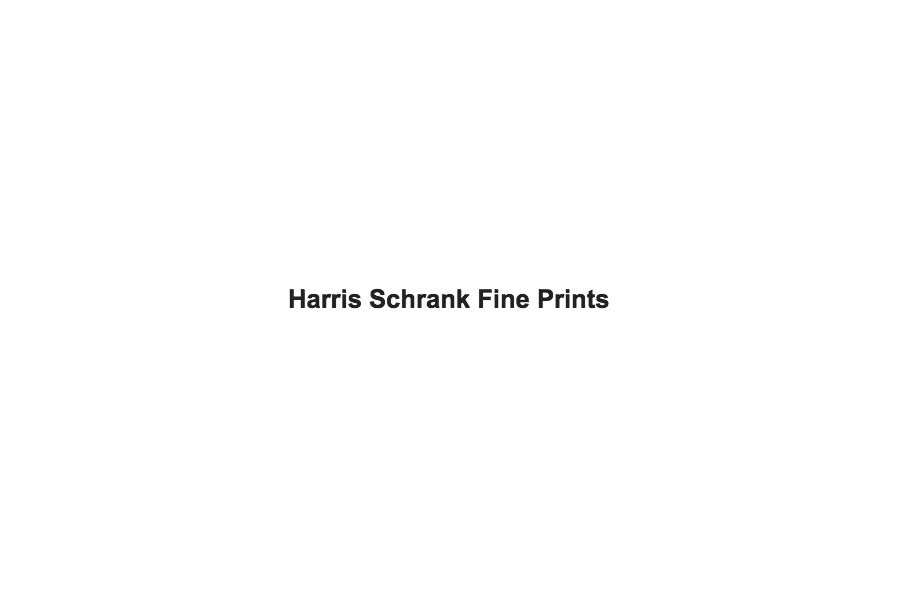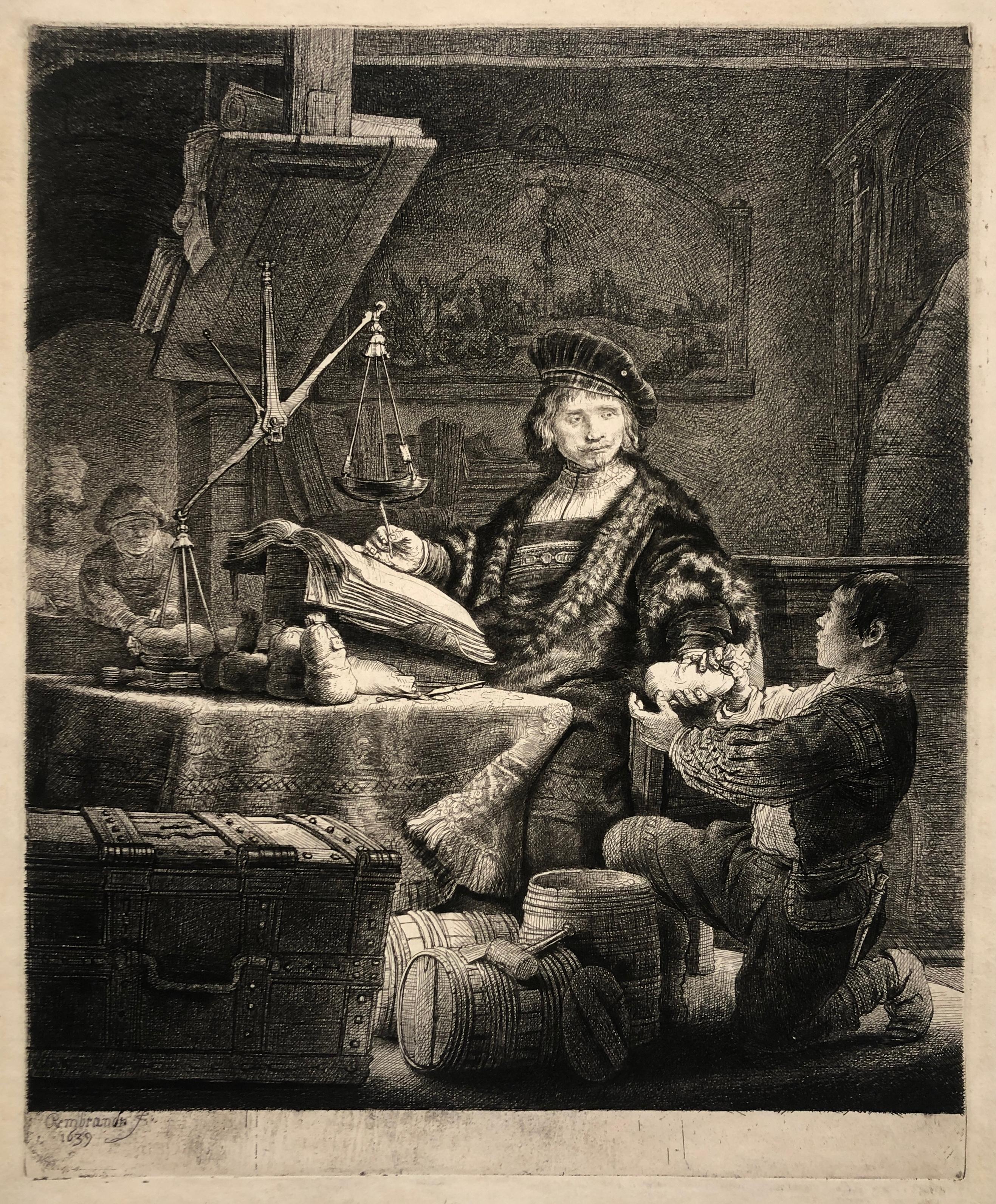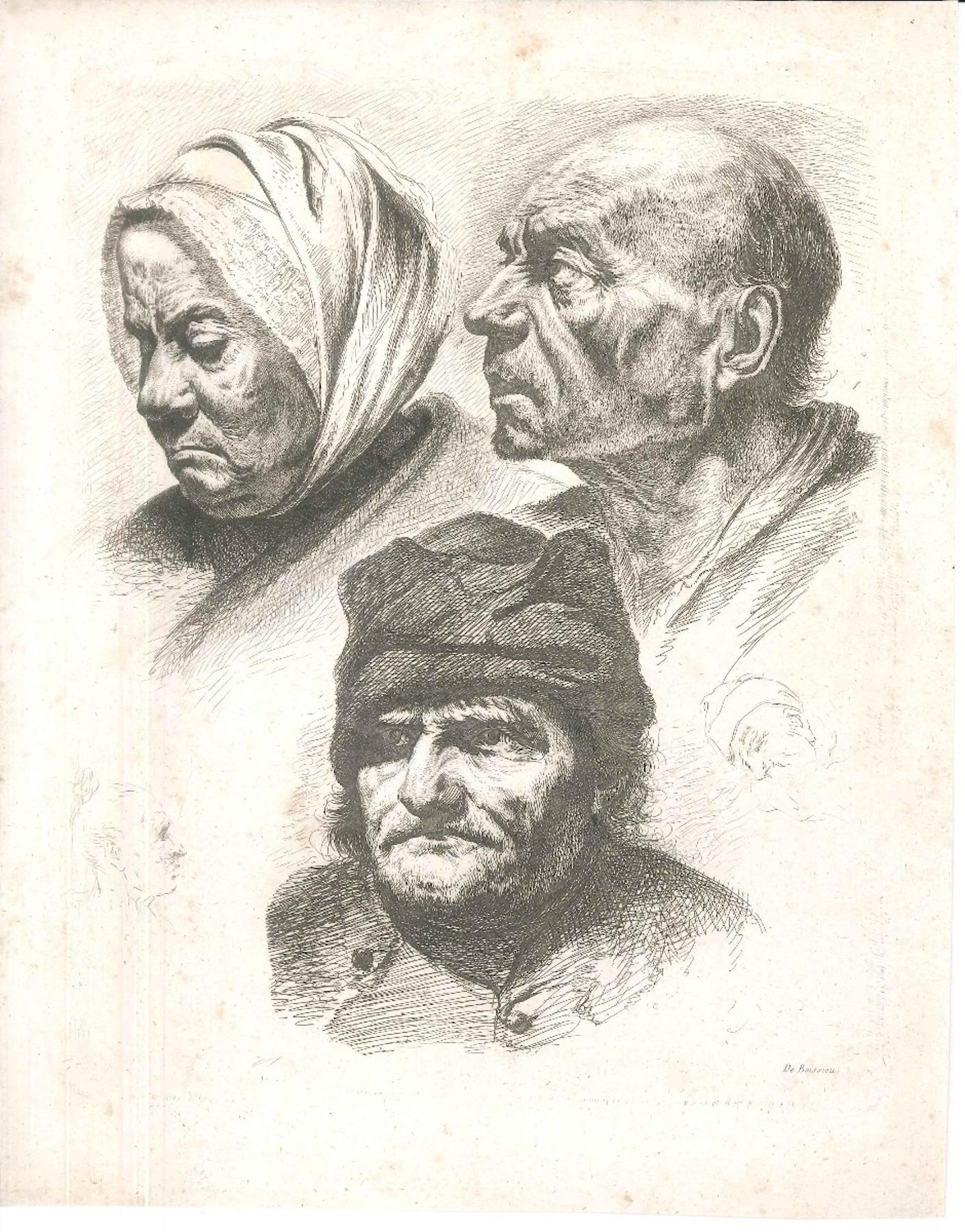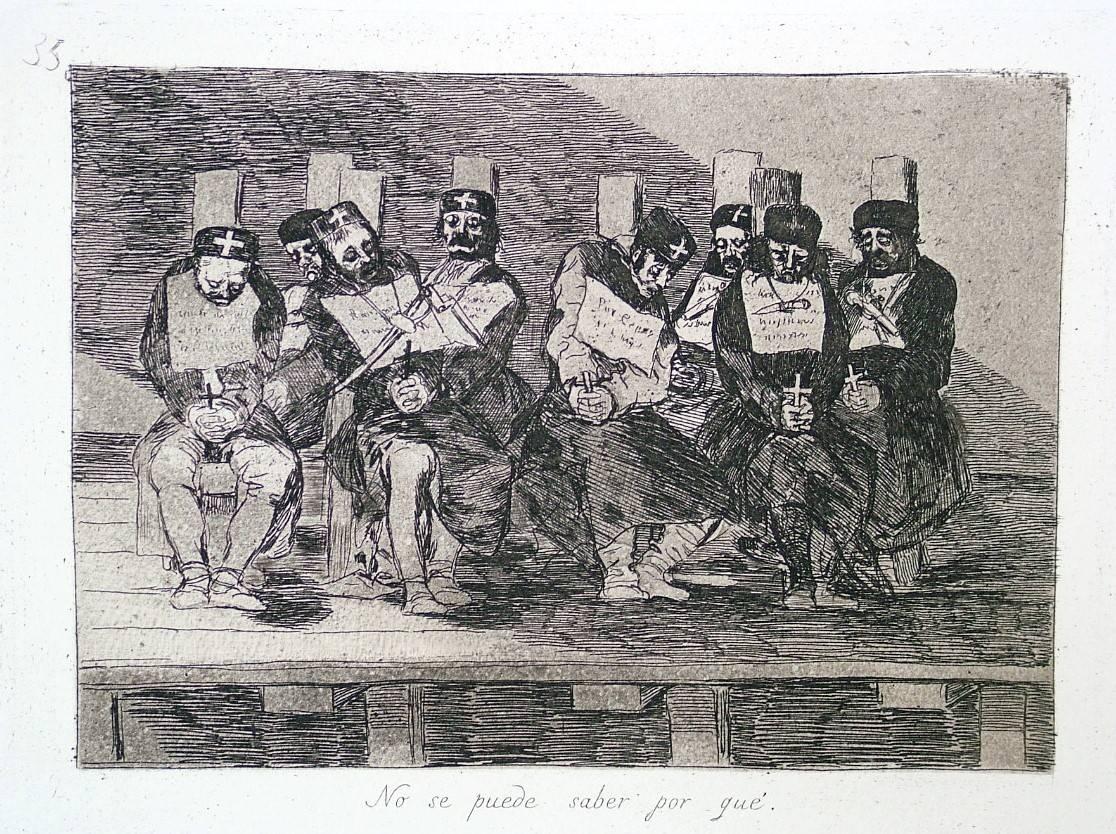Items Similar to Descending from the Cross, by Torchlight
Want more images or videos?
Request additional images or videos from the seller
1 of 2
Rembrandt van RijnDescending from the Cross, by Torchlight1654
1654
About the Item
Rembrandt Harmensz. van Rijn
1606 Leiden – Amsterdam 1669
The Descent from the Cross by Torchlight 1654
etching and drypoint; sheet 213 x 163 mm (8 3/8 x 6 7/16 inches)
Bartsch 83, White/Boon only state; Hind 280; The New Hollstein 286 first state (of four)
watermark
foolscap with five-pointed collar (Hinterding variant G-b-a; vol. 2, p. 123, vol. 3, p. 214 ill.)
provenance
P. & D. Colnaghi & Co., London (their stock no. in pencil verso C.31001)
The Montclair Art Museum, Montclair, New Jersey;
sale, Christie’s, New York, May 13, 1997, lot 237 (sold $34,500 to C.G. Boerner)
private collection, Germany (acquired in 1997);
thence by descent
A fine impression with patches of burr in the central group of figures; in impeccable, untreated condition with small margins all round.
- Creator:Rembrandt van Rijn (1606 - 1669, Dutch)
- Creation Year:1654
- Dimensions:Height: 8.38 in (21.29 cm)Width: 6.44 in (16.36 cm)
- Medium:
- Movement & Style:
- Period:
- Condition:
- Gallery Location:New York, NY
- Reference Number:1stDibs: LU51536469192
Rembrandt van Rijn
Rembrandt was the most influential 17th Century Dutch painter. After years of early success as a portrait painter, his life was beset by financial hardship and personal tragedy. He continued to paint portraits and develop etchings. Rembrandt's portraits of his contemporaries, self-portraits and illustrations of scenes from the Bible are regarded as his greatest creative triumphs. His self-portraits form a unique and intimate autobiography, in which the artist surveyed himself without vanity and with the utmost sincerity. Like many artists of the Dutch Golden Age, such as Jan Vermeer of Delft, Rembrandt was also an avid art collector and dealer. Rembrandt never went abroad, but he was considerably influenced by the work of the Italian masters and Netherlandish artists who had studied in Italy, like Pieter Lastman, the Utrecht Caravaggists, Flemish Baroque, and Peter Paul Rubens. Rembrandt's foremost contribution in the history of printmaking was his transformation of the etching process from a relatively new reproductive technique into a true art form, along with Jacques Callot. His reputation as the greatest etcher in the history of the medium was established in his lifetime and never questioned since. Few of his paintings left the Dutch Republic while he lived, but his prints were circulated throughout Europe, and his wider reputation was initially based on them alone.

About the Seller
4.9
Recognized Seller
These prestigious sellers are industry leaders and represent the highest echelon for item quality and design.
Established in 2000
1stDibs seller since 2016
100 sales on 1stDibs
Typical response time: 3 hours
Associations
International Fine Print Dealers Association
- ShippingRetrieving quote...Ships From: New York, NY
- Return PolicyA return for this item may be initiated within 7 days of delivery.
More From This SellerView All
- One Can't Tell Why - Proof from the Disasters of WarBy Francisco GoyaLocated in New York, NYFrancisco José de Goya y Lucientes (1746 Fuendetodos – Bordeaux 1828), No se puede saber por qué – One can’t tell why ca. 1808–1814, etching, burnished aquatint, drypoint, an...Category
1810s Old Masters Figurative Prints
MaterialsDrypoint, Etching, Aquatint
- Am Ufer (At the Riverbank)By Max PechsteinLocated in New York, NYMax Pechstein (1881-1955), Am Ufer (At the Riverbank), etching and drypoint, 1920, signed in pencil lower right, with the blindstamp of Die Schaffenden lower left, Plate 9 from Die S...Category
1920s Expressionist Figurative Prints
MaterialsEtching, Drypoint
- Couple Under a TreeBy Elyse Ashe LordLocated in New York, NYElyse Ashe Lord (1900-1971), Couple Under a Tree, c. 1930, color etching, soft ground, drypoint; signed lower right in pencil and numbered by the artist lower left. In very good condition, the full sheet, 11 3/4 x 12 1/4, the sheet 17 x 16 inches. A fine impression, with strong colors and plate tone. Printed on a light laid ivory Japan...Category
1930s Art Nouveau Figurative Prints
MaterialsEtching, Drypoint
- La CorridaBy Hermine DavidLocated in New York, NYHermine David (1886-1970) La Corrida, etching and drypoint, 1929, signed and numbered (20/100) in pencil (Inventaire Bibliotheque Nationale de France #22)....Category
1920s Realist Figurative Prints
MaterialsEtching, Drypoint
- AuctionBy Bernhard KretzschmarLocated in New York, NYBernard Kretzschmar (1889-1972), Auction, etching, drypoint, and burnished aquatint, 1921, signed and dated (’20) in pencil lower right [also initialed in the plate lower left] Refe...Category
1920s Expressionist Figurative Prints
MaterialsDrypoint, Etching, Aquatint
- Exterminating AngelBy James EnsorLocated in New York, NYJames Ensor (1860-1949), Exterminating Angel (L'Ange Exterminateur), etching with drypoint, 1889, signed and dated in pencil lower right, also titled and countersigned verso. Referen...Category
1880s Symbolist Figurative Prints
MaterialsDrypoint, Etching
You May Also Like
- Jan Uytenbogaert, The GoldweigherBy Rembrandt van RijnLocated in Boston, MABartsch 281, Hind 167 iii/III, Nowell-Usticke 281, iii/III. A fine impression, with burr, as retouched by Baillie in 1792. With an unidentified collectors stamp, verso.Category
17th Century Old Masters Figurative Prints
MaterialsDrypoint, Etching
- Study of Six Heads - Etching by J.-J. BoissieuBy Jean-Jacques de BoissieuLocated in Roma, ITStudy of Six Heads is a beautiful black and white etching with drypoint interventions on paper, realized at the end of XVIII century by the French artist Jean-Jacques de Boissieu (Lyon, 1736- 1810). Six study od heads ( four elder men, a middle-aged man at the center, and a woman with turbant) etched with a superb technique and an incredible draftsmanship are drawn to different scales and with different degrees of finish, have the dignity of six different portraits with the same passion and effort. Signed on plate on lower right margin “De Boissieu”. Inscription ( number plate) on higher-right corner "10". This old master’s original print with lifetime impressions, is in very good conditions, except for a usual yellowing of the paper above all on the edges and some signs of the time,do not affect the image. Jean-Jacques de Boissieu (Lyon,1736 –1810) Jean-Jacques de Boissieu was a French artist studied at the École de Dessin in Lyon, but he was mostly self-taught. His first prints were realized between 1758–64. When he went to Italy in the retinue of the ambassador and Duc de la Rochefoucauld d’Enville, he had the lifechanging encounter: he met Voltaire and he entered in the world of luminaries, he had the opportunity of realizing some plates for the Diderot-d’Alembert’s Encyclopèdie. Then he continued to produce prints in Lyon, Boissieu made many etchings of the Roman and Dutch countryside, as well as the French countryside around Lyon, which earned him a reputation as the last representative of the older etching...Category
Late 18th Century Old Masters Animal Prints
MaterialsEtching, Drypoint
- The Sacrifice of IphigeniaBy Nicolas BeatrizetLocated in Roma, ITBlack and white etching and drypoint on wire rod paper, representing the myth of the sacrifice of Iphigenia. On the altar is inscribed "Iphigenia" in capital letters. On the lower left margin is inscribed "N. Beatrizet Lo Taringus F.", slightly discolored (Beatrizet usually signed his plates with the letters "N. B. L. F."). At the center of the lower margin is inscribed "Romae, Michaelis Tramezini formis cum privilegio summi Pont. M.D.L.III". After a drawing attributed to either Michelangelo Buonarroti, Salviati, or Baccio Bandinelli...Category
16th Century Old Masters Figurative Prints
MaterialsDrypoint, Etching
- Study of Five Heads - Original Etching by J.-J. BoissieuBy Jean-Jacques de BoissieuLocated in Roma, ITStudy of Five Heads is a beautiful black and white etching with drypoint interventions on paper, realized at the end of XVIII century by the French artist Jean-Jacques de Boissieu (Lyon, 1736- 1810). Five study of heads of which two profiles (a female and a male) are lightly sketched with the drypoint technique, and we could appreciate the incredible draftsmanship. Instead, the bigger three portraits are very detailed and etched with a superb technique. Although the subjects are drawn in different scales and with different degrees of finish, each portrait has the dignity of a unique piece and the composition is very balanced. In particular on the lower margin at the center there is the portrait of "Le Père Cotrot, Garçon Teinturier à Lyon'", an elderly man, toothless and with a large-nosed, slightly turned to left, with a hat and unbuttoned jacket over waistcoat, shows all his wrinkles in a very realistic way. Signed on plate on lower right margin “De Boissieu”. This old master’s original print with fresh impressions, is in very good conditions, except for a usual yellowing of the paper above all on the edges and some signs of the time and light foxing along the margins, do not affect the image. Jean-Jacques de Boissieu (Lyon,1736 –1810) Jean-Jacques de Boissieu was a French artist studied at the École de Dessin in Lyon, but he was mostly self-taught. His first prints were realized between 1758–64. When he went to Italy in the retinue of the ambassador and Duc de la Rochefoucauld d’Enville, he had the lifechanging encounter: he met Voltaire and he entered in the world of luminaries, he had the opportunity of realizing some plates for the Diderot-d’Alembert’s Encyclopèdie. Then he continued to produce prints in Lyon, Boissieu made many etchings of the Roman and Dutch countryside, as well as the French countryside around Lyon, which earned him a reputation as the last representative of the older etching...Category
Late 18th Century Old Masters Animal Prints
MaterialsEtching, Drypoint
- Breaking up of the Agamemnon, No 1By Sir Francis Seymour Haden, R.A.Located in Storrs, CTEtching and drypoint. Schneiderman 133.v/xi. 7 3/4 x 16 3/8 (sheet 9 1/4 x 17 1/2). A rich impression with plate tone printed in black/brown in on antique cream wove paper. Signed in pencil. In this state, according to Schneiderman (p. 273):"With additional etched work: an extra balk of timber has been added to the balk in the right foreground (the tip of which is approx. 135 mm. from the right plate mark and 35 mm. from the bottom); the barges made darker, and there are drypoint touches in the water in front of the stern. The extreme left line of the hoist of the wrecking barge is complete. The faint lines in the area of the sail of the passing ship just to the right of the mizzenmast of the Agamemnon have also disappeared." The etching, one of Haden's largest, was too large to publish in The Portfolio. Subsequently the plate was proved by Haden and printed by the foremost plate printer of the day, Frederick Goulding, and was issued by the artist himself through Colnaghi’s – with immense success. Keppel claimed that the print sold 10,000 copies, though around 500 seems more likely.' Breaking up of the Agamemnon...Category
Mid-19th Century Old Masters Landscape Prints
MaterialsDrypoint, Etching
- Giovanni Piranesi Etching of Ancient Roman Architecture, 18th CenturyBy Giovanni Battista PiranesiLocated in Alamo, CA"Veduta del Sepolcro della Famiglia Plauzia per la Strada Che Conduce da Roma a Tivoli vicino a Ponte Lugano" from "Le Antichità Romane" (Roman Antiquities), one of the most famous works by Piranesi. "Antichita" illustrates the tombs along the Appian Way...Category
Early 18th Century Old Masters Figurative Prints
MaterialsDrypoint, Engraving, Etching
Recently Viewed
View AllMore Ways To Browse
From The Antique
Antique Cross
Antique Crosses
All Cross
Fine Cross
German Cross
17th C Etchings
Rembrandt Cross
C G Boerner
Vintage Map Of New York City
Warhol Garden
1886 Russia
1886 Russian
Antique Wood Printing Blocks
Artist Vin
British Male Nudes
Collaboration Takashi Murakami Louis Vuitton
Francoise Gilot Picasso






